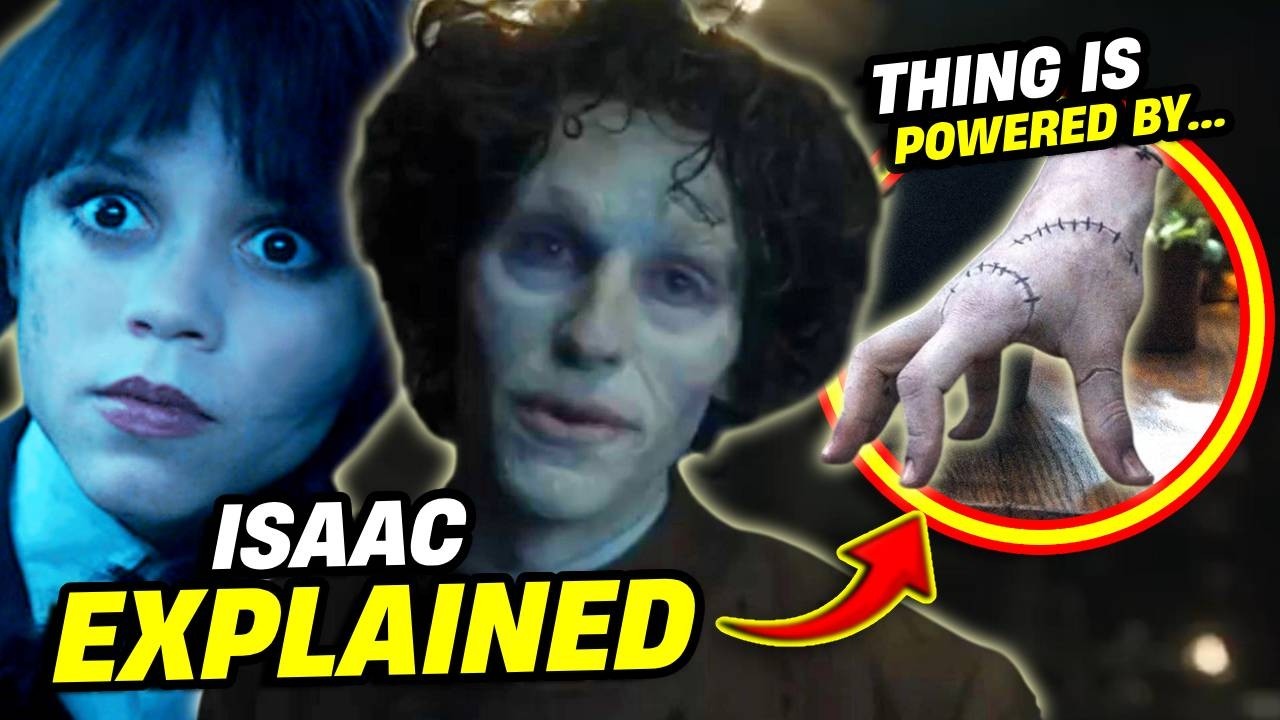The Addams family’s darkest secret just clawed its way out… 🖤 Slurp, the zombie with a ticking heart, hides a truth that could shatter Wednesday’s world. Who is Isaac Night, and why does his shadow haunt Nevermore? 😱 This villain’s twisted past is shaking fans to their core! Dive into his chilling story and share your wildest theories—what’s his next move?

It’s a rainy September afternoon in 2025, and I’m holed up in my apartment, the rain tapping against the window like impatient fingers, still processing the whirlwind that was Wednesday Season 2. Netflix unleashed the full season on September 3, and while the gothic vibes and Jenna Ortega’s unflinching portrayal of Wednesday Addams had me hooked from the start, it’s the revelation of Slurp—better known as Isaac Night—that’s lodged itself in my brain like a splinter I can’t ignore. This zombie-turned-villain, brought to undead life by Owen Painter, isn’t just a creepy side plot; he’s the thread that unravels the Addams family’s carefully woven tapestry of secrets, forcing us to rethink everything we thought we knew about their quirky, macabre legacy. As someone who’s been a Addams Family fan since I was a kid sneaking late-night viewings of the old movies, watching Isaac’s story unfold felt like uncovering a hidden room in the family mansion—one filled with dusty blueprints, broken hearts, and a clockwork ticking that echoes through generations.
Let’s start from the grave, because that’s where Isaac Night literally begins in Season 2. Early on, during the Founders’ Pyre—a ritual at Nevermore Academy that’s equal parts bonfire and bad omen—Pugsley Addams (Isaac Ordonez), Wednesday’s mischievous little brother, sneaks off to the Skull Tree, a gnarled sentinel on campus with a hollow eye that’s always seemed a bit too watchful. Pugsley, with his budding electrokinesis (a power inherited from his dad, Gomez), hears a faint ticking and, in a moment of boyish curiosity, zaps the tree. Out crawls Slurp: a rotting, brain-hungry zombie with bleary eyes, a gaping hole in his head from decades of decay, and an insatiable appetite that has him slurping down mystery meat sandwiches (and later, far worse) to regenerate. Pugsley, thrilled to have a “pet,” chains him up in Eugene Ottinger’s bee shack, naming him Slurp for his noisy eating habits. It’s played for dark comedy at first—Pugsley feeding him brains from the school cafeteria, Slurp shambling around like a loyal (if grotesque) sidekick. But as the season progresses, especially in Part 2, Slurp starts to change. His flesh knits back together, his eyes clear, and suddenly, he’s not just a mindless ghoul anymore. He speaks. He schemes. And when he greets his old mentor, Professor Augustus Stonehearst, with a casual “Hello, old friend” before devouring his brain, we realize: this is no ordinary zombie. This is Isaac Night, resurrected and ready for revenge.
Isaac’s origin story, revealed in flashbacks that feel like Tim Burton’s love letter to classic horror, is a masterclass in tragic villainy. Born frail with a congenital heart defect, young Isaac spent his childhood confined to bed, his mind racing while his body failed him. He sketched inventions—gears, pistons, impossible machines—to cheat death, and in a feat of desperate genius, he built himself a clockwork heart: a mechanical marvel powered by outcast magic and raw ingenuity that kept him alive but left him forever changed, his emotions as rigid as the ticking inside his chest. By the time he arrived at Nevermore Academy three decades ago, Isaac was a prodigy in the DaVinci faction—a group of telekinetic inventors who built wonders from scrap. Mentored by the enigmatic Augustus Stonehearst, Isaac was given a secret lab in Iago Tower, where he poured his brilliance into one obsession: curing his sister, Francoise Galpin (Frances O’Connor), a Hyde whose uncontrollable transformations were slowly killing her. Francoise wasn’t just family; she was Isaac’s anchor, the one person who saw past his cold exterior to the boy desperate to protect what little he had left.
Enter Gomez Addams (played in flashbacks by Lucius Hoyos), Isaac’s roommate and unwitting pawn. Gomez, with his natural charm and electrokinetic sparks, became Isaac’s closest friend—or so Isaac thought. To power his Hyde-curing machine, Isaac needed a sacrifice: someone whose outcast energy could fuel the device. He chose Gomez, viewing him as expendable despite their bond. But Morticia Frump (Gwen Jones in the past, Catherine Zeta-Jones in the present), Gomez’s fierce love, discovered the plot. In a frenzy of loyalty and rage, she severed Isaac’s right hand with an axe, triggering an explosion that buried the lab in flames and “killed” Isaac. That severed hand? It reanimated on its own, becoming Thing—the Addams family’s loyal, scurrying companion. “Night” is an anagram of “Thing,” a clever nod that retroactively ties the hand’s quirky antics in Seasons 1 and 2 to Isaac’s lost limb. Morticia and Gomez, under blackmail from Stonehearst, buried Isaac’s body under the Skull Tree, his clockwork heart still faintly ticking like a promise of unfinished business. They covered it up, adopting Thing as their own, and moved on to build the life we know—complete with Wednesday and Pugsley. But secrets like that? They don’t stay buried.
What elevates Isaac from a standard baddie to a legacy-shifter is how his resurrection exposes the Addams family’s underbelly. Up until Season 2, the Addamses were portrayed as gloriously unapologetic weirdos—embracing the macabre with a wink and a tango. But Isaac forces them to confront their capacity for murder, betrayal, and cover-ups. Morticia’s confession to Wednesday in Episode 7—“We buried him, but not his pain”—is a rare crack in her poised facade, her eyes shadowed with the weight of a choice made in youth. Gomez, usually the jovial heart of the family, grapples with guilt over losing a friend to his own oblivious charm. And Thing? That little hand’s loyalty to the Addamses now feels bittersweet—born from violence, yet choosing family over its original master. In the finale, when Thing rips out Isaac’s clockwork heart to save Wednesday from a fatal burial, it’s not just a heroic moment; it’s a poetic full circle, Isaac’s own creation turning against him. Fans on Reddit have been tearing apart that scene, calling it “the emotional core of the season,” with threads debating whether Thing’s “choice” implies some lingering sentience from Isaac’s telekinesis.
Isaac’s villainy is laced with tragedy, making him one of Wednesday’s most layered antagonists. Owen Painter nails the duality: Slurp’s shambling, brain-munching horror gives way to Isaac’s cold intellect, his voice a silky drawl laced with bitterness. “People do drastic things for the people they love,” Painter told Tudum, capturing Isaac’s motivation—saving Francoise twisted him into a monster, but it was love that started it all. His plan in Season 2? Kidnap Pugsley (whose sparks mirror Gomez’s) to power the machine anew, curing Francoise and her son Tyler (Hunter Doohan), the Hyde from Season 1 who’s now on the loose again. Tyler, it turns out, is Isaac’s nephew, adding a familial knot that pulls Tyler deeper into the chaos. Doohan and Painter’s scenes together—two men yearning for a mother’s/sister’s love, manipulated by Isaac’s promises—are raw, with Doohan describing it as a “master-Hyde relationship” laced with jealousy. Isaac lures Tyler with visions of family reunion, but it’s all a ploy to harness his Hyde rage for the machine.
This revelation ripples through the ensemble, deepening Wednesday’s world. Wednesday herself, ever the detective, pieces together Isaac’s puzzle through psychic visions and crystal ball glimpses, confronting her parents’ past in a way that humanizes them. “Am I like him?” she asks Morticia, staring at his journal scrawled with blueprints and pleas for Francoise—a moment that forces Wednesday to question if her own relentless drive could lead to similar darkness. Enid (Emma Myers), Wednesday’s colorful counterpart, grapples with her Alpha werewolf arc, her loyalty tested as she helps trap Isaac in Iago Tower. Bianca (Joy Sunday) uses her siren powers to track Slurp’s trail, while Ajax (Georgie Farmer) and Eugene (Moosa Mostafa) uncover the lab’s horrors. Grandmama Hester (Joanna Lumley) drops cryptic hints about Isaac’s experiments, her cackle masking old regrets. Even Larissa Weems (Gwendoline Christie), lingering as a ghostly advisor, warns of the “ticking debt” the Addamses owe.
Burton’s touch elevates it all—the stop-motion flashbacks of young Isaac sketching his heart, Francoise fading beside him, feel like a nod to Corpse Bride, blending whimsy with woe. The Skull Tree, with its mechanical tick, becomes a character itself, a monument to buried sins. Fans lost it online: TikTok edits of Slurp’s regeneration synced to Eilish’s “Bury a Friend” racked up millions of views, while X threads debated Isaac’s “tragic hero” status versus straight-up monster. Reddit’s r/WednesdayTV is ablaze with theories—did Thing spare Isaac’s heart for Season 3? Could Francoise’s LOIS experiments (that secret program at Willow Hill) tie back to his machine? Filming for Season 3 starts next spring in Ireland, and with teases of a Fester spinoff, Isaac’s shadow feels far from lifted.
For me, Wednesday is personal. I was 15, sneaking Addams Family reruns, dreaming of Wednesday’s fearless vibe. Isaac Night’s story hits hard—a genius undone by love, his legacy tied to Thing, the Addamses’ heart. He forces Wednesday to face her family’s sins, redefining their quirky darkness as a tapestry of guilt and sacrifice. Will his shadow linger in Season 3? Could his heart tick again? The moment Thing rips it out, choosing the Addamses, broke me. With 2027 looming, I’m stocking up on black candles and snacks, ready to binge and unravel Isaac’s legacy. Wednesday isn’t just a show; it’s a crypt of secrets, and Isaac Night’s the key that unlocked its darkest door.





